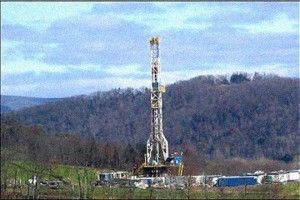What CA fracking advocates can learn from PA
by CalWatchdog Staff | January 31, 2013 2:37 am
Jan. 31, 2013
By Chris Reed
 As Californians begin to appreciate the immense economic potential[1] of the state’s underground natural gas and oil reserves, the debate will sharply intensify over the safety of hydraulic fracturing — the newly refined and improved tool used to access previously unreachable reserves. Fracking, the shorthand term for the process, involves using high-powered streams of water, with a small amount of chemicals and solids or sand, to break up rock formations thousands of feet underground.
As Californians begin to appreciate the immense economic potential[1] of the state’s underground natural gas and oil reserves, the debate will sharply intensify over the safety of hydraulic fracturing — the newly refined and improved tool used to access previously unreachable reserves. Fracking, the shorthand term for the process, involves using high-powered streams of water, with a small amount of chemicals and solids or sand, to break up rock formations thousands of feet underground.
Of the states most associated with fracking — North Dakota, Texas, Ohio and Pennsylvania — what has happened in the latter is of most interest to Californians. In the Keystone State, the use of fracking to tap vast natural gas reserves in an underground formation called the Marcellus Shale flourished under a liberal Democratic governor, Ed Rendell. The former Philadelphia mayor simply never gave credence to the various scare tactics used to try to block fracking and brushed off the criticism from the Philadelphia Inquirer editorial page, environmental groups and others with an ideological, quasi-religious abhorrence of fossil fuels.
If Democratic Gov. Jerry Brown is to be persuaded to follow Rendell’s path, advocates of fracking need to learn from Pennsylvania and how the debate unfolded there.
Stick to the facts to counter hysterics
Advocates should argue that fracking is not perfect, but that no oil exploration is, and note that when properly regulated, it has a strong safety record. Scott Perry, who was the director of the Pennsylvania Department of Environmental Protection’s Bureau of Oil and Gas Management under Rendell, liked to respond to the harshest critique with this just-the-facts statement: “There has never been any evidence of fracking ever causing direct contamination of fresh groundwater in Pennsylvania or anywhere else.”
The argument that fracking, which is typically at a depth of 5,000 feet or more, might affect water tables thousands of feet higher isn’t one that most scientists take seriously. John M. Deutch, an MIT chemistry professor who served in high posts in the Carter and Clinton administrations and has been a key adviser to the U.S. Energy Department on fracking, says careful regulation addresses environmental fears in comprehensive fashion. He adds that fracking “is by far the biggest event that I’ve seen” in 50 years of monitoring world energy developments.
What’s striking about media coverage of fracking safety questions is how it largely ignores the fact that the Obama administration rejects the alarmism of the Sierra Club and the Natural Resources Defense Council. In House testimony[2] in May 2011, EPA Director Lisa Jackson said she was “not aware of any proven case where the fracking process itself has affected water.” The U.S. Geological Survey dismissed the idea[3] that fracking causes earthquakes. Most definitively, a November 2011 Energy Department study[4] concluded that there were legitimate pollution concerns surrounding hydraulic fracturing. But the concerns involved the worries about surface air and water quality and about community effects that would come with any heavy industrial project, and were not due to the deleterious effects of fracking underground.
Efficiency gains: It’s not the chemicals, it’s the computers
In explaining why fracking is so much more effective than it used to be, advocates should stress that it is a result of computing power — not more toxic and dangerous chemicals. Drillers are now able to use extraordinarily sophisticated sensors to take the equivalent of a gigantic MRI of underground rock formations, then focus their water cannons on weak spots in the formations surrounding the shale formations with natural gas and oil reserves.
Now, as in the past, by volume the chemicals and sand used are less than 1 percent of the total water used. Because of fracking’s increased efficiency, this means much less water is used than in past versions — and thus fewer chemicals.
Another claim regularly invoked by fracking critics is that the process wastes an extraordinary amount of water. But the Marcellus Shale Coalition says 90 percent of the water used is recycled, and that far more water is used in Pennsylvania on golf courses than in fracking. The recycling percentage is only going to improve as focus grows[5] on the importance of reuse.
The ‘Goebbels’-like anti-fracking documentary
Fracking supporters can shore up their case by pointing to the intentional deception in a 2010 anti-fracking documentary, “GasLand.”[6] The movie’s most unforgettable image is residents of a town in a heavy drilling area — Dimock, Pa. — lighting their tap water on fire, leaving the plain impression this was the result of fracking. Instead, even director Josh Fox acknowledged in an interview with McClatchy-Tribune that it resulted from local conditions unrelated to the chemicals used in fracking. Fox, however, insisted it wasn’t misleading.
Defenders of Pennsylvania’s fracking record like to bring up “GasLand” because they know it is so easily discredited. In a 2011 interview with a newspaper in Lancaster, Pa., Teddy Borawski, chief oil and gas geologist for the state Department of Conservation and Natural Resources, relished the chance to tee off on the documentary. “Joseph Goebbels would have been proud,” he said. “He would have given him the Nazi Award. That, in my opinion, was a beautiful piece of propaganda.”
And in the war of talking points, the fact is that fracking has actually led to the single best news on the U.S. environmental front in many years. Natural gas is much cleaner than coal and oil, and fracking has increased supplies so dramatically that it now costs only a third or less of what it did in 2008 in the United States. The result: “The amount of carbon dioxide being released into the atmosphere in the U.S. has fallen dramatically to its lowest level in 20 years,” as AP reported[7] last summer.
The irony could hardly be greater. For decades, environmentalists have argued that renewable energy such as solar and wind power are the only way to reduce the release of dangerous emissions into the atmosphere. But it is plentiful new supplies of a fossil fuel, natural gas, that has been the game changer. The U.S. has reduced carbon dioxide emissions more than any other nation since 2006, according to the International Energy Association.
 California could thrive if it joins the “brown energy” revolution. The Monterey Shale formation under the Central Valley is far bigger than the Marcellus Shale formation under Pennsylvania and other northeastern states. As the Wall Street Journal reported on Jan. 15, “The overall economic benefits of opening up the Monterey Shale field could reach $1 trillion.”
California could thrive if it joins the “brown energy” revolution. The Monterey Shale formation under the Central Valley is far bigger than the Marcellus Shale formation under Pennsylvania and other northeastern states. As the Wall Street Journal reported on Jan. 15, “The overall economic benefits of opening up the Monterey Shale field could reach $1 trillion.”
Allowing fracking to work its magic will be especially difficult in a state that is home to AB 32 and that is ground zero for regulatory excesses[8] in the name of preventing pollution. But while governor of Pennsylvania from 2003-2011, Ed Rendell overcame reflexive green objections with his just-the-facts approach. It can work in California, too.
- immense economic potential: http://www.city-journal.org/2012/22_3_oil.html
- House testimony: http://www.youtube.com/watch?v=im-yJhCHhCo
- dismissed the idea: http://www.guardian.co.uk/environment/2012/apr/18/us-earthquakes-fracking-gas
- Energy Department study: http://www.shalegas.energy.gov/resources/111811_final_report.pdf
- focus grows: http://online.wsj.com/article/SB10001424052970203937004578077183112409260.html
- “GasLand.”: http://www.imdb.com/title/tt1558250/
- AP reported: http://news.yahoo.com/ap-impact-co2-emissions-us-drop-20-low-174616030--finance.html
- regulatory excesses: http://www.autoblog.com/2009/03/25/california-to-reduce-carbon-emissions-by-banning-black-cars/
Source URL: https://calwatchdog.com/2013/01/31/what-ca-fracking-advocates-can-learn-from-pa/